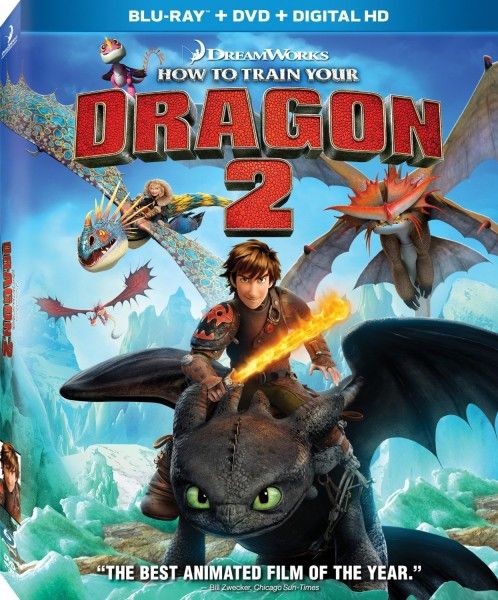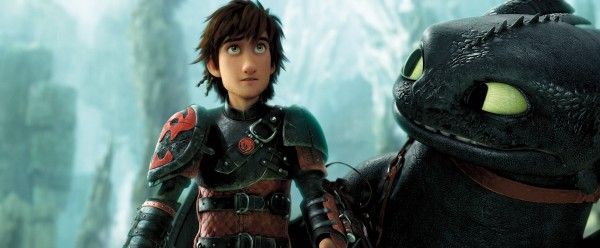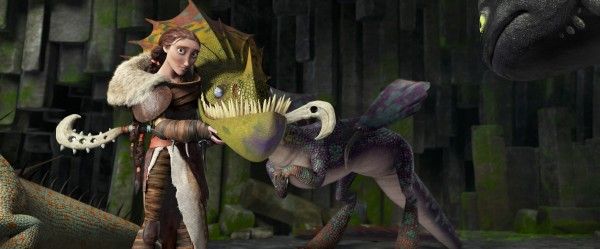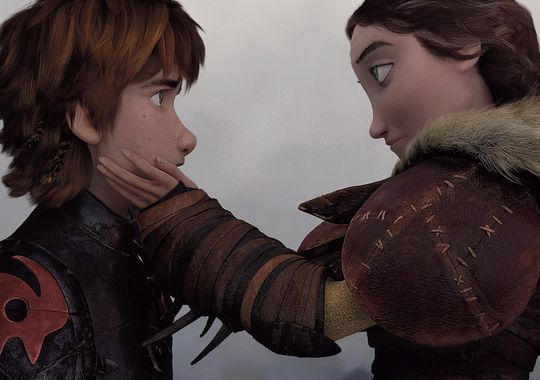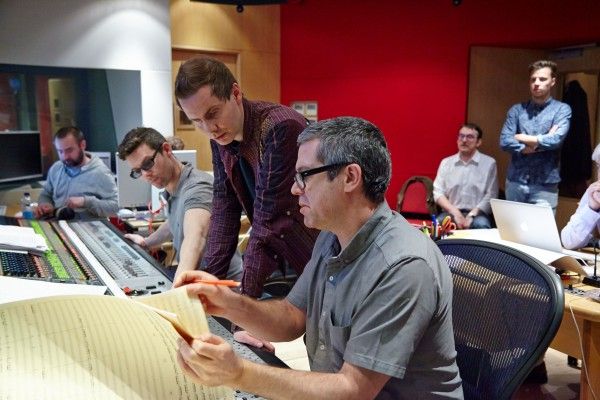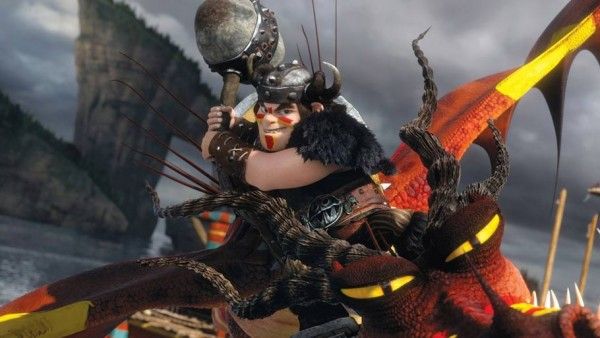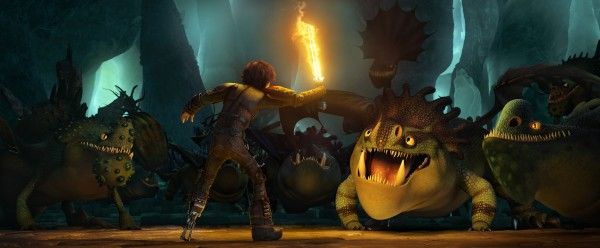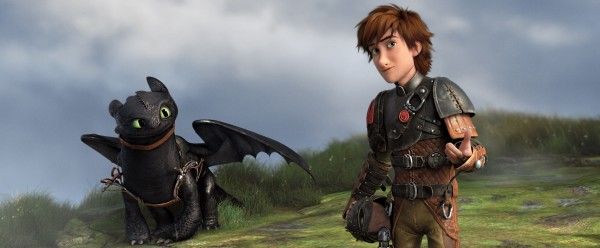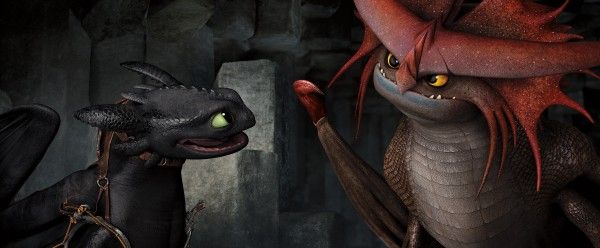DreamWorks Animation’s How to Train Your Dragon is one of my favorite animated films of the past decade, and so I came into this summer’s sequel, How to Train Your Dragon 2, with some sky high expectations. Luckily, director Dean DeBlois delivered a follow-up that maintained the sensibilities that made his 2009 film so great while also expanding the scope and raising the emotional stakes of the franchise with this follow-up. What makes the Dragon films unique is that they are deeply compassionate in nature, which is sadly something that’s all too rare in film these days. Throw in astounding visuals, an incredible score by composer John Powell, and organic, compelling character evolution, and How to Train Your Dragon 2 manages to be not only one of the best animated films of the year, but one of the best films of the year period.
In anticipation of the Blu-ray release of How to Train Your Dragon 2 on November 11th, I recently got the chance to hop on the phone with DeBlois. After I gushed about his films and directorial talents for far too long, the filmmaker discussed his behind-the-scenes documentary that’s included on the Blu-ray, the major story changes that took place during production, the difficulty of telling a mother-son story, the fact that Powell one-upped himself with the score, where he’s at with How to Train Your Dragon 3, and much more. If you’re a fan of animation and/or the Dragon movies, the interview is a fascinating read. Take a look after the jump.
Adam: First of all, I just want to say thank you. These films you’ve made are so fantastic and unique, and deeply compassionate which I think is a quality that’s lacking in a lot of films these days.
DEAN DEBLOIS: Thank you, wow that’s a great compliment.
I definitely want to ask you about this making-of documentary that’s on the Blu-ray. While a lot of people hype up deleted scenes and such, I’m obsessed with bonus materials like this that really show you how the film was put together. What kind of access can fans expect from this documentary, which I believe you directed as well?
DEBLOIS: Yeah I supervised it I don’t know if I quite directed it, but it’s all from my point of view because ever since Lilo & Stitch I’ve been carrying around a video camera to most every meeting and event that we have associated with the movie. And most of it’s garbage, a lot of it’s really uninteresting, but every now and then I managed to capture something that was happening in the moment that’s really, I think, pretty exciting. Like you, I would buy DVDs purely for the making of sometimes, and a lot of it has been a part of my film education so I feel a responsibility and the dedication to want to describe a little bit of the process for anyone who’s interested in watching it. But it’s not too inside baseball in that it’s not full of technical terms and everything else. Hopefully it’s a brief but kind of informative account of how certain elements came to be and a little bit of background insight into some of the more unique elements about this particular movie.
Those kinds of bonus materials are almost like a free film school for people, and a lot of the animated DVDs are geared towards kids so I was excited to see that this documentary was on the Dragon Blu-ray.
DEBLOIS: Have you seen the documentary?
I haven’t, I was told the Blu-rays aren’t ready yet but I’m very much looking forward to seeing it.
DEBLOIS: Well I shot enough material for probably like a 10-hour documentary (laughs). So it is cut down and it doesn’t go into too much depth, but it does cover a lot of ground in terms of how certain scenes came to be, working with John Powell the composer, working with Jonsi who wrote some of the music along with John, working with the actors, the animators, going through the test screening process. So hopefully it takes the audience along a journey from basic ideas and inception through to the final deliver of it, some of the highlights and some of the challenges along the way.
How soon after the first film did you have the story for this sequel outlined? Did it take a while to flesh it out or was there one idea that you felt strongly about exploring for the follow-up?
DEBLOIS: Well I was asked by Jeffrey Katzenberg to start coming up with ideas while we were still doing the final sound mix on the first film. I have a very distinct memory of fleshing out the first outline in a little notebook, sitting at a picnic table that overlooks a baseball field at Skywalker Ranch. There I kind of knew the building blocks of it, that Hiccup would discover that there was a vigilante out there rescuing dragons from a conqueror who was hell bent on building a dragon army, and that that vigilante would turn out to be his long lost mother and that she would represent everything that he was kind of pining for at a moment when he’s being tasked with taking over his father’s mantle as a stay-at-home Chief, very grounded and very responsible. To me the next act of this trilogy was always going to be Hiccup defining himself against the very powerful force of two domineering parents, in a way.
Obviously filmmaking is a fluid process and movies go through a number of changes during production that result in the finished film. Were there any big story changes that were made later on in the process or was it pretty nailed down by the time you guys got into the animation phase?
DEBLOIS: Well one of the biggest changes to the story, and it did come later than I would’ve liked because I think we could’ve done a better job of integrating it if I knew that we were going to go that direction, was the notion of Valka being the sympathetic antagonist of the movie. That was her original role, that Hiccup not only found this character kind of living in the wild like Jane Goodall or Diane Fossey and not only is she his mother but she would represent on one side everything he aspired to be, this life of not only wild abandon but also dedicated purpose, importance, out there saving dragons and living a very dragon-centric life, learning all of their secrets and becoming like a dragon herself. All of that, to Hiccup, would be amazing but at the same time they would clash in a fundamental way on the idea that Hiccup believes wholeheartedly in coexistence and that it’s possible among humans and dragons, whereas Valka in her years of defending dragons from Drago’s forces and trappers and whatnot had come to distrust humans so deeply that she believed the only way to really protect them was to hide them away, to segregate them.
And so the original third act of the movie was Hiccup flying to Berk to try to stop his mother from extracting the dragons, because she knew that Drago was coming. Drago was always meant to be a villain for the third movie, but his sense of his encroaching armies would be present. So it was at once she’s everything he hopes to be, but also the antithesis of who he is. We discovered probably mid-way through the process of making the film that that idea was maybe just a little too challenging for our audience, if you think of all the kids kinda turning to their parents and saying, “Why is Hiccup fighting his mom? And why is his mom taking away the dragons?” You realize that’s probably, although kinda cool and Shakespearean, probably a little heavy and a little challenging for the kids, in particular the moms and the parents that take their kids to these movies (laughs).
(Laughs) That’s understandable. Well you mentioned the test screening process, what did you learn from that? Was this one of the big changes that came out of that process, or were there any big notions that you went “Oh wow we didn’t get that across quite clear enough”?
DEBLOIS: Oh yeah definitely, there are always clarity issues. But Valka continued to be a character that we had to massage. I think when you’re dealing with a mother in particular, there’s an archetype there that doesn’t want to be tampered with. Any mother who was not there for her child, regardless of circumstance, is seen as somehow abandoning him, so we really had to work that and make sure that Valka was sympathetic although flawed. I think we struck a good balance. She’s still interesting and I think she’s definitely redeemable, but she hasn’t completely lost the edge of who she is and the character flaws that make her interesting.
Absolutely. It’s really tough to introduce new characters in sequels and have them be an organic part of the story, but I think you guys pulled it off wonderfully.
DEBLOIS: Oh thank you, thanks.
One of my favorite aspects of this series is John Powell’s score, which I think is just magnificent. I spoke to him this summer about his work on the film, but I was wondering if you could talk a little bit about your collaboration. I think it’s one of the most integral parts of the movie because it immerses you in this world and kind of carries you emotionally through the story.
DEBLOIS: I wholeheartedly agree. For me, I relish that part of the process. John likes to come into it as late as possible because he wants to be grabbed and inspired by the story, and then do his work immediately. But he did watch an earlier screening of this film and he had time to really develop a few themes that he was playing with. For me, I think of John as a collaborator on the story front as much as he is somebody that brings exquisite finish to the movie. A good score is, I think, like a third of the storytelling if it’s been done well (laughs). He certainly thinks about it as a storyteller, and he finds themes that I might not even be aware of. In particular, he kept talking about how this film is filled with characters who are lost and found. They’re all in a state of either losing themselves or finding themselves, or finding each other, and I think that’s a really interesting way to look at it but I hadn’t considered that. But he built his whole score around that notion, so he’s underscoring scenes that have a very deliberate storytelling approach in terms of the dialogue, but he’s filling it in and he’s giving it texture and nuance by underscoring a different aspect of it, about characters being alienated from one another or coming back together or struggling to find themselves, and I just think that’s brilliant.
Definitely.
DEBLOIS: I don’t know how he managed to do it exactly, but he certainly managed to outdo himself. Because as much as I love the first score from the first film, he actually managed to make it more sophisticated and richer and somehow more compelling even. I think it’s his best score yet.
Oh I agree, it’s tremendous work. When he told me he was going to take a break from scoring I was like, “No!”
DEBLOIS: (Laughs) It actually benefits us because he comes to the project very, very fresh because he’s had a lot of time to sort of rest up in between.
Well the animation world is constantly changing due to advances in technology. How has the actual process of animating a film at DreamWorks evolved since you worked on the first movie?
DEBLOIS: There’s been a tremendous leap on this movie, because for about five years DreamWorks was developing with Intel a complete overhaul on all the tools we use, and we were the first film to showcase them. So they came to us kind of brand new and we were anticipating a lot of bugs, but it actually turned out that we weren’t slowed down by them at all, we went a lot faster. And it’s simply because, although it’s very, very powerful—the whole suite is called Apollo, but the animation tool is called Primo and the lighting tool is called Torch, and in both cases they allow the artists to kind of work with their hands again. The animators are now working with Cintiq tablets, which are computer screens that you can actually use a stylus to draw on, and they’re manipulating the characters live so they can change expressions, they can pose them, and create their animation without any wait time. That allowed us to have really complex characters with many more controls, both visible and under the skin, performing in real time, and we could have multiple characters onscreen at once which was never possible before.
So the whole laborious process of animating, which used to be all based on spreadsheets and graphs and numeric entries and pull-down menus, it’s all been replaced with a hand holding a stylus and manipulating the character like a stop-motion animator would move around the armature of a puppet. So it allowed for lots of iterations, really nuanced performances, and in the cases of scope and scale we could have a scene like the battle on the beach of Valka’s dragon sanctuary where we have thousands of soldiers and hundreds of dragons and explosions and all that sort of thing going off at once. That just would not have been possible even a year before we had the new software.
Well it looks fantastic. I definitely want to ask about How to Train Your Dragon 3. How is development on that film going? Do you have the story worked out yet?
DEBLOIS: Well just this past Thursday I presented the outline for the film and I’m gonna take a two week break, but after that I’ll be working on the screenplay and hopefully turning the first draft in by the end of the year. So all is going well. It continues to be the third act of this trilogy and we get to see Hiccup’s coming of age come to a completion. I’m also playing with the idea of what happened to the dragons and why they are no more, as suggested by Cressida Cowell’s books. So the whole mystery of where did they go? Did they come back? What transpired? I think it’s all compelling stuff and it’s definitely a story that’s gonna have a lot more Toothless emphasis in it. We continue to get more insight into the dragon world and shed light on their intelligence and all the aspects that we’ve been slowly cooking over the last two films.
The release date was recently pushed back a year from 2016 to 2017. Are you doing any reworking of the story or was that simply a studio decision?
DEBLOIS: It’s just that these movies take three years. I think it was a little ambitious to say 2016 (laughs). As is normally the case, they kind of throw darts out into the future and wherever they land they call that a release date until we start talking about it in practical terms, and then it’s like, “Uh yeah that’s not enough time.” (laughs). So knowing that they take three years from this moment, from outlining and writing the screenplay through to the final lighting of it, it’s just a process of building models and doing tests and animating, storyboarding, the whole thing just adds up to about three years.
You said you initially envisioned Drago as the villain for the third film, so after those changes in Dragon 2 has there been further tweaking on the story for Dragon 3?
DEBLOIS: Yeah there is further tweaking. The one regret I have with Drago is had I known that he was going to be brought in as a significant villain in the second film I would’ve brought him in sooner so that we could do more character development on him. I think he’s a little stiff, he’s a little cardboard as a character, he doesn’t have the layers of depth that the other characters have and that’s simply because he didn’t have the screentime. So as I go forward I’m still working on kind of the antagonist story of the whole thing, but there are layers and textures to go to that I think will make for a much more compelling force of antagonism in this third one.
I know you initially envisioned this as a trilogy of films, but when I spoke with John Powell he mentioned that Jeffrey Katzenberg brought up the prospect of making a fourth movie while you guys were in Cannes. Is that being discussed?
DEBLOIS: (Laughs) I think I’ve talked [Katzenberg] down from that. There may be spinoffs to come, but my involvement and my dedication to completing a story that has a reason for being and a strong sense of integrity and three chapters I think is in place and intact. Everybody seems to be in agreement that we’re moving in the right direction.
Well as you are kind of seeing the light at the end of the tunnel for this franchise, are you thinking about what you might want to do after the series is over? You have experience directing the Sigur Ros documentary, are you thinking about live-action? Are there more animated ideas you’d like to do?
DEBLOIS: I am, live-action is definitely interesting to me and I expect and hope to be doing something in live-action in the future, but for the next three years I’ve got my hands tied and plenty to think about (laughs), so I guess I’m not even gonna really go there just yet.
Sure, I understand. Well I definitely want to ask about 3D. It feels like something that everyone was talking about a few years ago, but nowadays it doesn’t feel like U.S. audiences are as enthusiastic about the format anymore. Do you have a preference for how these films are seen? I mean I know you ensure that it’s effective either way, but how involved are you in the 3D process?
DEBLOIS: Well I think in our case 3D has been an asset. It really seems to have dialed up the visceral feel of the flight sequences, you kinda feel immersed, you feel like you’re part of what’s going on and sitting on the back of a dragon, but also on the storytelling front it’s been really effective in moments like in the first film where Hiccup and Toothless have that moment of communion where Hiccup touches him for the first time, and in this movie where Valka’s apologizing to Hiccup for having been away and can we start over. Those close moments of connection where we in a very subtle way dial up the depth and bring the audience closer to the emotion has been very effective, so I like to think that we use it well and it’s definitely worth the extra money if it’s available for you. But like you say, it’s not the cart that leads the horse, and we make sure that the storytelling is effective whether or not you see it in 3D. But should you choose to see it in 3D, I think it’s not an afterthought, it’s definitely something that we’ve used as a storytelling tool.
Yeah it seems like the live-action 3D is what’s really kind of become an afterthought, but the animated realm really lends itself to three-dimensions, especially something like this where it opens with this big dragon games sequence.
DEBLOIS: Yeah I think because we originate in 3D we can make the best use of it. Unfortunately there are so many films that have come out where the after-conversion has kind of taken the special quality out of the 3D and it’s just become a bit of a gimmick to soak a little bit more money out of the audience. So unfortunately it kind of ruined it (laughs). The trust has been lost, to some degree, by the audience. I’m always a person that’s a little suspicious of anything that’s been converted in post, but if I know that it’s been originated, either in live-action or animation, I’m intrigued.
One of the things that was really interesting and kind of bold about How to Train Your Dragon 2 was the time jump. Was that something you stumbled on early on?
DEBLOIS: Yeah, I was conscious of the fact that by the end of the first movie, Hiccup was a guy who had all of his problems solved. He was no longer aching for the approval of his father, or the acceptance of his community, or the attention of Astrid—he had all of those things plus a super cool dragon and he had ended a war. So he was a guy without a problem, and starting any story I’m always looking for “Who’s the hero and what’s his problem?” and that had me think of Hiccup as an older character going through another very universal rite of passage, which is kind of stepping with trepidation into adulthood with uncertainty over who you are and what you are to become. So against the backdrop of two overbearing parents, it seemed like a good story worth telling and one that had purpose instead of just recycling the same material. So I think that’s why the five-year jump actually was quite effective, and it also gave us kind of a neat thing to do which was age up our entire cast and make sure we didn’t lose their personalities while we redesigned them and brought new aspects to them.
How to Train Your Dragon 2 is currently available on Digital HD and will be available on Blu-ray and DVD on November 11th.


